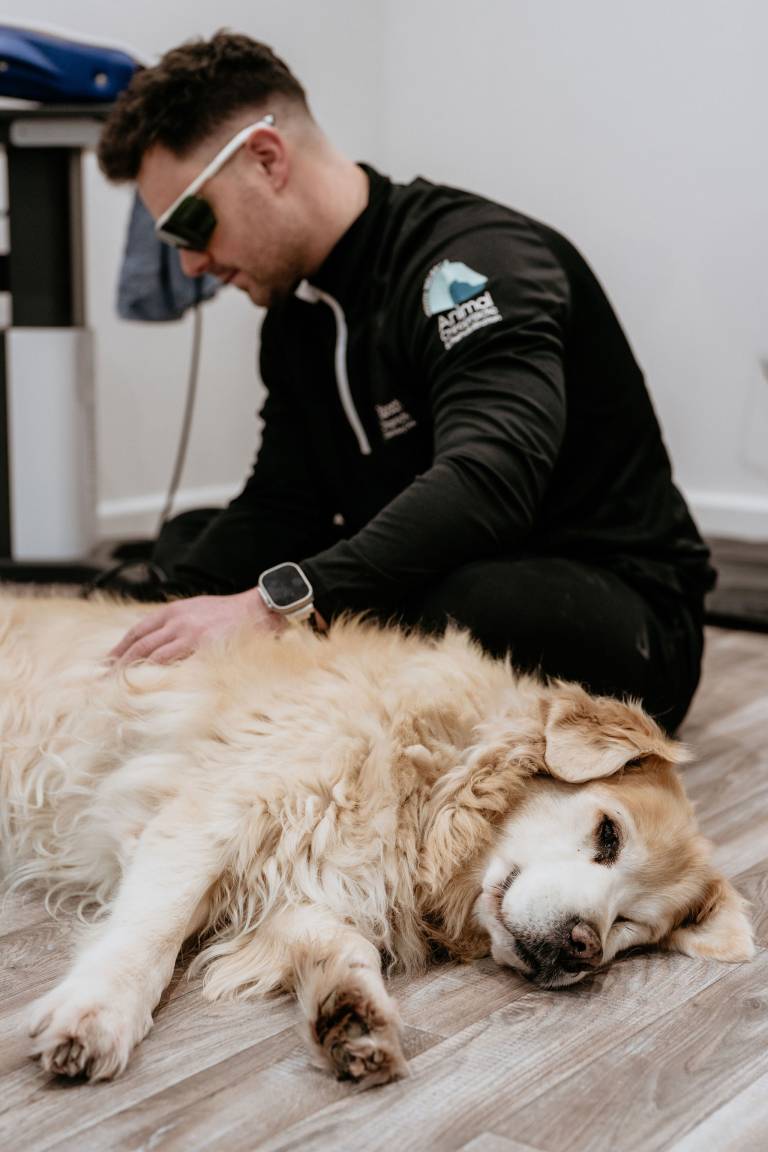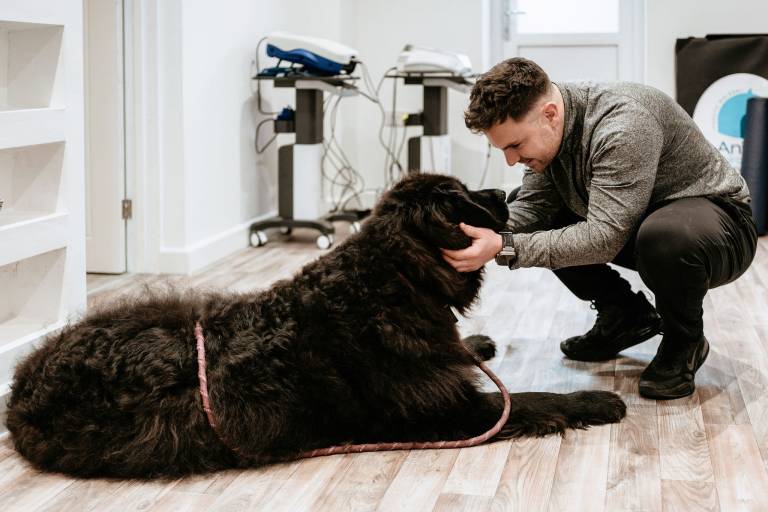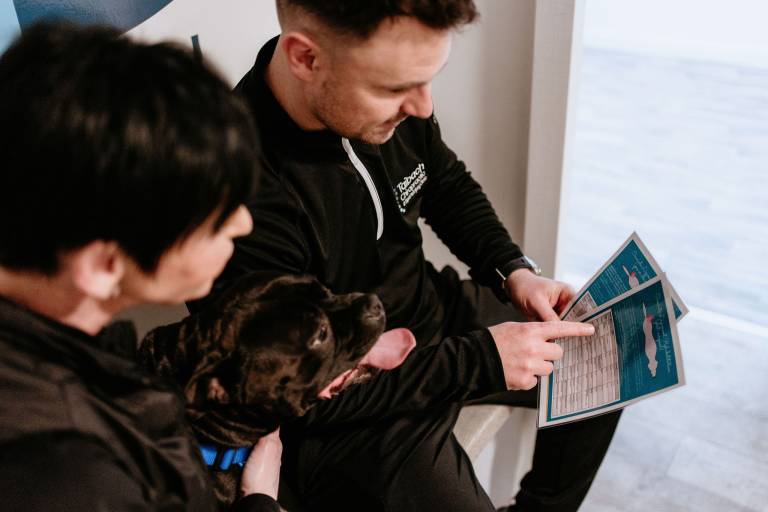Post Surgical Care

Here at Animal Chiro SW we routinely manage and help dogs that have undergone recent surgery. From Cruciate ligaments, Hip dysplasia, elbow dysplasia and spinal operations we have the knowledge and equipment to aid your dog back to full fitness and mobility
Chiropractic care and rehabilitation play a vital role in the recovery and overall well-being of dogs after surgery. Whether the surgery was for an injury, orthopaedic procedure such as cruciate ligament or spinal operation, or soft tissue repair, these therapies can significantly enhance recovery outcomes, reduce pain, and improve mobility. Post-surgical dogs often face a period of rest and limited movement, which can lead to muscle atrophy, stiffness, and decreased range of motion. Chiropractic care and rehabilitation provide a comprehensive approach to helping these dogs regain strength, comfort, and quality of life.
1. Pain Relief and Inflammation Reduction
After surgery, pain and inflammation are common, especially around the incision site or the area where the procedure was performed. Chiropractic adjustments can help by realigning the spine and joints, improving circulation and promoting the body’s natural healing processes. Spinal adjustments can also reduce the strain on surrounding muscles and tissues, decreasing discomfort and promoting more effective healing. In addition, chiropractic care can help relieve pain associated with the muscle tension that often develops when a dog compensates for the surgical site.
Rehabilitation therapies such as massage, heat or cold therapy, and laser therapy further help reduce inflammation and soothe painful areas. These treatments assist in improving blood flow to the affected regions, supporting tissue repair and reducing swelling, which can expedite recovery and improve comfort.
2. Improved Range of Motion and Joint Mobility
One of the major goals after surgery, particularly orthopaedic surgeries like hip replacement or ligament repairs, is to restore normal joint function and prevent stiffness. Post-surgical dogs can develop restrictions in joint mobility due to muscle guarding, scar tissue formation, or inactivity during recovery. Chiropractic care can aid in improving the alignment of the spine and extremities, thus promoting better movement. When the skeletal system is properly aligned, the nervous system functions optimally, which can enhance joint mobility and flexibility.
Rehabilitation exercises such as passive range of motion (ROM) movements or targeted stretching help maintain and improve the flexibility of joints and muscles during recovery. These exercises can be gradually introduced as the dog heals, helping to ensure the recovery of full range of motion in the affected area and prevent long-term joint stiffness or deformity.

3. Muscle Strengthening and Restoration of Function
Post-surgical dogs often experience muscle atrophy due to immobility or reduced activity levels during their recovery period. Chiropractic care helps to restore proper alignment and nerve function, which can stimulate muscle activation. When the spine and joints are correctly aligned, the muscles surrounding those structures are more likely to respond appropriately to signals from the brain, promoting healthier muscle tone and strength.
Rehabilitation, including physical therapy and exercise programs, is crucial for strengthening muscles that may have weakened during the recovery period. Gradual, controlled exercises, including underwater treadmill therapy, therapeutic ball work, and proprioceptive training, can rebuild muscle strength and coordination. These exercises also help improve balance and stability, which are essential for preventing reinjury once the dog returns to full activity.
4. Preventing Secondary Complications
After surgery, dogs are at risk of developing secondary complications, including joint stiffness, muscle imbalances, and compensation injuries. If a dog favors one side of its body or alters its gait due to pain or weakness in the surgical area, this can lead to overuse injuries in other parts of the body. Chiropractic care addresses these concerns by restoring the balance and alignment of the entire musculoskeletal system, ensuring that the dog moves symmetrically and efficiently as it recovers. Chiropractors can identify and correct areas of the body that may be compensating for the surgical site, helping prevent new injuries from forming.
Rehabilitation helps address specific deficits that arise from surgery, such as strength, coordination, or flexibility issues. It works to retrain the dog’s body to move normally, and avoid imbalances or improper movement patterns that can lead to compensatory injuries.

5. Enhancing Overall Recovery and Well-being
Both chiropractic care and rehabilitation have a holistic approach to post-surgical recovery. Chiropractic adjustments not only focus on the musculoskeletal system but also aim to improve the function of the nervous system. When the spine is properly aligned, the nervous system can more effectively communicate with the muscles, joints, and tissues, which accelerates the healing process. This ensures that all the body’s systems are working optimally to support the dog’s recovery.
Rehabilitation, which may include hydrotherapy, therapeutic massage, and specific exercises, also supports overall health and helps the dog maintain an optimal body weight, reducing stress on healing joints and muscles. Mental stimulation and gradual reintroduction to physical activity also contribute to a dog’s emotional well-being during recovery. The therapeutic bond that develops between a dog and a rehabilitation therapist can be reassuring, reducing anxiety and promoting a positive healing experience.
6. Faster Return to Normal Activity
The ultimate goal of chiropractic care and rehabilitation for post-surgical dogs is to get them back to their normal activity level as quickly and safely as possible. By addressing pain, improving mobility, restoring strength, and preventing complications, these therapies can help dogs recover faster and return to activities such as walking, running, or playing. A well-structured rehabilitation plan that combines chiropractic adjustments with targeted exercises will enable the dog to regain confidence and agility, ensuring a smoother transition back to everyday life.
Tailored care when they need it most! Chiropractic care and rehabilitation therapies offer invaluable benefits for post-surgical dogs, facilitating pain relief, improved mobility, muscle strength, and overall recovery. By addressing the body’s alignment and promoting functional healing, these therapies help prevent complications, reduce recovery time, and ensure a return to optimal physical function. Together, chiropractic and rehabilitation provide a comprehensive, holistic approach to post-surgical recovery, improving the quality of life for dogs and helping them get back to doing the activities they love.



